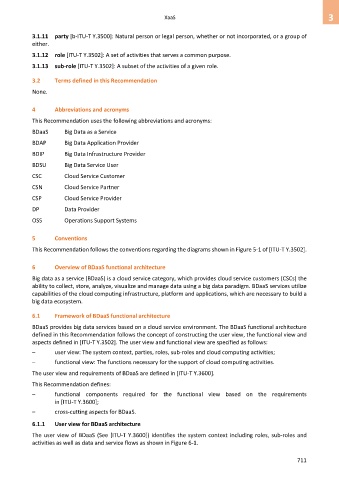Page 719 - Cloud computing: From paradigm to operation
P. 719
XaaS 3
3.1.11 party [b-ITU-T Y.3500]: Natural person or legal person, whether or not incorporated, or a group of
either.
3.1.12 role [ITU-T Y.3502]: A set of activities that serves a common purpose.
3.1.13 sub-role [ITU-T Y.3502]: A subset of the activities of a given role.
3.2 Terms defined in this Recommendation
None.
4 Abbreviations and acronyms
This Recommendation uses the following abbreviations and acronyms:
BDaaS Big Data as a Service
BDAP Big Data Application Provider
BDIP Big Data Infrastructure Provider
BDSU Big Data Service User
CSC Cloud Service Customer
CSN Cloud Service Partner
CSP Cloud Service Provider
DP Data Provider
OSS Operations Support Systems
5 Conventions
This Recommendation follows the conventions regarding the diagrams shown in Figure 5-1 of [ITU-T Y.3502].
6 Overview of BDaaS functional architecture
Big data as a service (BDaaS) is a cloud service category, which provides cloud service customers (CSCs) the
ability to collect, store, analyze, visualize and manage data using a big data paradigm. BDaaS services utilize
capabilities of the cloud computing infrastructure, platform and applications, which are necessary to build a
big data ecosystem.
6.1 Framework of BDaaS functional architecture
BDaaS provides big data services based on a cloud service environment. The BDaaS functional architecture
defined in this Recommendation follows the concept of constructing the user view, the functional view and
aspects defined in [ITU-T Y.3502]. The user view and functional view are specified as follows:
– user view: The system context, parties, roles, sub-roles and cloud computing activities;
– functional view: The functions necessary for the support of cloud computing activities.
The user view and requirements of BDaaS are defined in [ITU-T Y.3600].
This Recommendation defines:
– functional components required for the functional view based on the requirements
in [ITU-T Y.3600];
– cross-cutting aspects for BDaaS.
6.1.1 User view for BDaaS architecture
The user view of BDaaS (See [ITU-T Y.3600]) identifies the system context including roles, sub-roles and
activities as well as data and service flows as shown in Figure 6-1.
711

